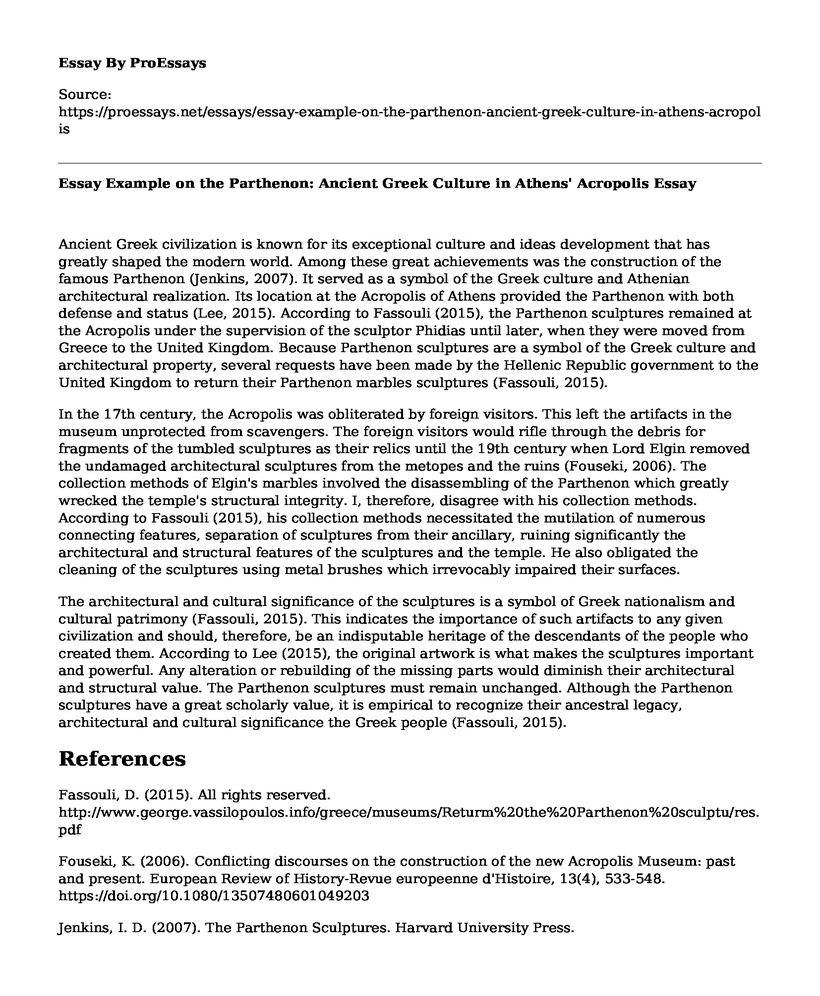Ancient Greek civilization is known for its exceptional culture and ideas development that has greatly shaped the modern world. Among these great achievements was the construction of the famous Parthenon (Jenkins, 2007). It served as a symbol of the Greek culture and Athenian architectural realization. Its location at the Acropolis of Athens provided the Parthenon with both defense and status (Lee, 2015). According to Fassouli (2015), the Parthenon sculptures remained at the Acropolis under the supervision of the sculptor Phidias until later, when they were moved from Greece to the United Kingdom. Because Parthenon sculptures are a symbol of the Greek culture and architectural property, several requests have been made by the Hellenic Republic government to the United Kingdom to return their Parthenon marbles sculptures (Fassouli, 2015).
In the 17th century, the Acropolis was obliterated by foreign visitors. This left the artifacts in the museum unprotected from scavengers. The foreign visitors would rifle through the debris for fragments of the tumbled sculptures as their relics until the 19th century when Lord Elgin removed the undamaged architectural sculptures from the metopes and the ruins (Fouseki, 2006). The collection methods of Elgin's marbles involved the disassembling of the Parthenon which greatly wrecked the temple's structural integrity. I, therefore, disagree with his collection methods. According to Fassouli (2015), his collection methods necessitated the mutilation of numerous connecting features, separation of sculptures from their ancillary, ruining significantly the architectural and structural features of the sculptures and the temple. He also obligated the cleaning of the sculptures using metal brushes which irrevocably impaired their surfaces.
The architectural and cultural significance of the sculptures is a symbol of Greek nationalism and cultural patrimony (Fassouli, 2015). This indicates the importance of such artifacts to any given civilization and should, therefore, be an indisputable heritage of the descendants of the people who created them. According to Lee (2015), the original artwork is what makes the sculptures important and powerful. Any alteration or rebuilding of the missing parts would diminish their architectural and structural value. The Parthenon sculptures must remain unchanged. Although the Parthenon sculptures have a great scholarly value, it is empirical to recognize their ancestral legacy, architectural and cultural significance the Greek people (Fassouli, 2015).
References
Fassouli, D. (2015). All rights reserved. http://www.george.vassilopoulos.info/greece/museums/Returm%20the%20Parthenon%20sculptu/res.pdf
Fouseki, K. (2006). Conflicting discourses on the construction of the new Acropolis Museum: past and present. European Review of History-Revue europeenne d'Histoire, 13(4), 533-548. https://doi.org/10.1080/13507480601049203
Jenkins, I. D. (2007). The Parthenon Sculptures. Harvard University Press. https://books.google.co.ke/books?hl=en&lr=&id=t02qLAT21AIC&oi=fnd&pg=PR4&dq=The+Parthenon+Sculptures&ots=SyI4g1c4Ir&sig=MH79-jAWO3IA9tQDc_J5jvxgRYQ&redir_esc=y#v=onepage&q=The%20Parthenon%20Sculptures&f=false
Lee, A. (2015). The Parthenon, Athena, and the Ideal Greek. https://ancientart.as.ua.edu/the-parthenon-athena-and-the-ideal-greek/
Cite this page
Essay Example on the Parthenon: Ancient Greek Culture in Athens' Acropolis. (2023, May 21). Retrieved from https://proessays.net/essays/essay-example-on-the-parthenon-ancient-greek-culture-in-athens-acropolis
If you are the original author of this essay and no longer wish to have it published on the ProEssays website, please click below to request its removal:
- The War of 1898
- US Civil War in Comparison with Rhodesian Bush War
- Essay Sample on US Policy in Afghanistan, Iran and Iraq
- Essay Sample on African American Slave History
- Pax Britannica and the Pax Americana Eras Essay Example
- African Americans: From Captivity to Freedom - Research Paper
- The Athenian Renaissance: From Ancient to Present Civilization - Essay Sample







